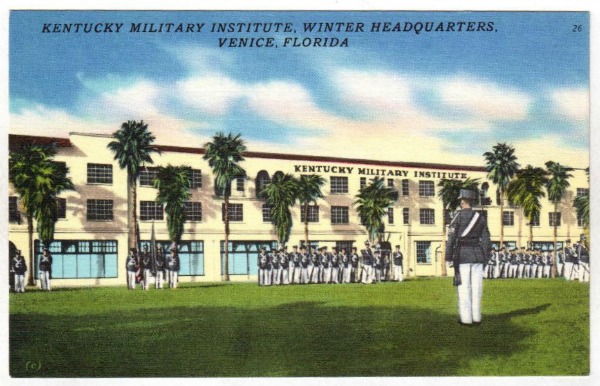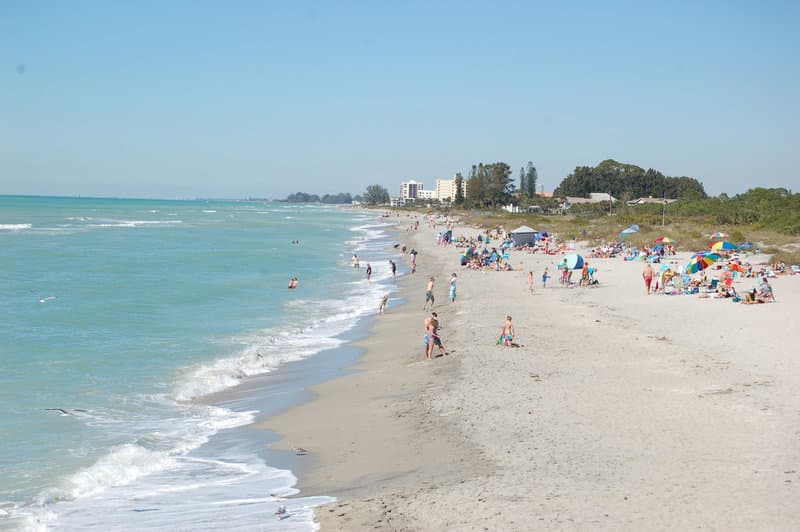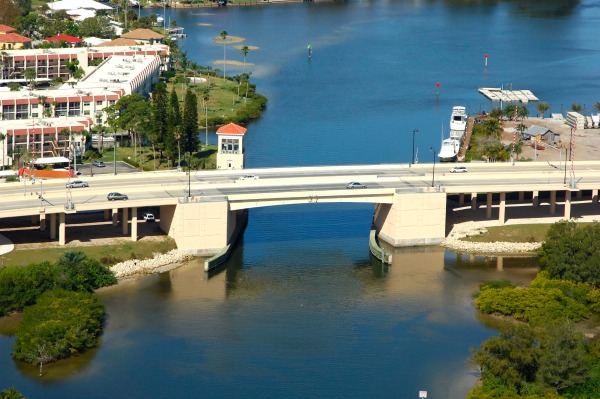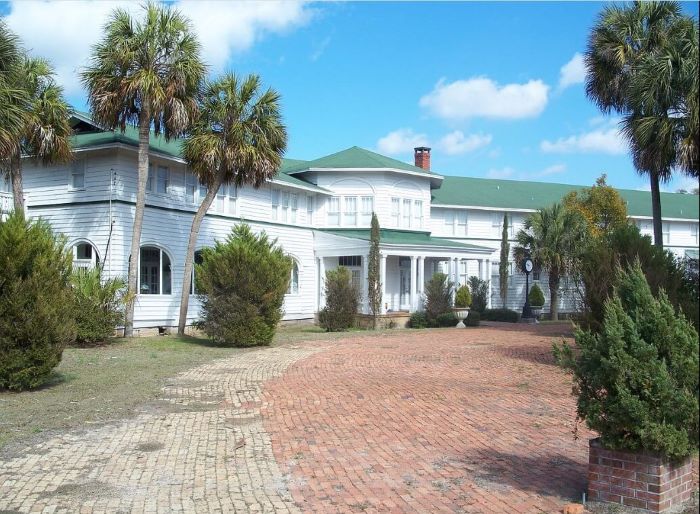- Home
- Florida Towns
- Venice
VENICE, FLORIDA and VENICE BEACH
By Mike Miller Updated June 1, 2024
Venice, Florida Things To Do, Lodging, Dining, & Real Estate At End Of Article
Venice, Florida is on the Gulf Coast about 18 miles south of Sarasota on the west side of I-75.
There are two exits into the Venice area: Exit 195, Laurel Road, will take you into the north side of town. Exit 193, Jacaranda Boulevard, takes you into downtown Venice.
Venice Beach is within the city limits of Venice. The population of Venice is about 27,000.
HISTORY OF VENICE FLORIDA
Venice began when an early pioneer, Richard Roberts started his homestead in the 1870's near Roberts Bay and the beach.
He planted an orange grove and a few other crops.
The area supported a few citrus operations, along with boat building and fishing until the turn of the century.
Another pioneer, Francis Higel, arrived from Europe with his wife and six sons, buying land from Mr. Roberts and helping to develop the area.
When the post office was established in 1888 Mr. Higel suggested the name Venice, due to the canals and its resemblance to his childhood home, the Italian city of Venice.
Things were pretty quiet until the railroad came to Sarasota County in 1911, and development followed in the path of the rails.
Bertha Honore' Palmer Invented Modern Venice
Not long after the railroad came to the county, Bertha Honore' Palmer, the widow of Chicago millionaire Potter Palmer, bought 60,000 acres in Sarasota County.
 Bertha Honore' Palmer
Bertha Honore' PalmerHer land development operation platted an area south of Robert's Bay and named it Venice, so the surrounding area became known as Venice and continued to grow.
Mrs. Palmer was a talented manager and businesswoman, and her arrival signaled the beginning of a new era.
The rails were extended to the new village.
The new little town began to grow slowly, but it remained a small citrus and fishing community until the 1920s Florida land boom.
Locomotive Engineers Put Venice On The Right Track
In 1925, Dr. Fred H. Albee, a prosperous orthopedic surgeon, purchased 2,916 acres of land from Mrs. Palmer.
He hired John Nolan, a city planner, to design a city on his land.
Dr. Albee's dream was to cure sick patients using the magic power of sunshine.
It's obvious Dr. Albee was not a dermatologist.
Before he started on his plan, however, he sold the land to the Brotherhood of Locomotive Engineers, a labor union.
The union organized BLE Realty Corporation to develop the property.
The main feature of the development plan was Venice Avenue, a 200 foot wide boulevard terminating at the Gulf of Mexico beach.
Construction got underway and the town began to emerge from the palmettos and sand dunes. The Hotel Venice opened in 1926.
It had 100
rooms with private baths, and was magnificent for its time.
The Hotel Venice morphed over the years into the Park View Hotel, the winter quarters of the Kentucky Military Institute, the Gulf Breeze Hotel, and others.
The building still stands at 200 Nassau Street in the heart of downtown and serves as an assisted living facility.
Venice was one of the first places in the state that had strict zoning regulations and design review requirements. All buildings had to be constructed in the Northern Italian Renaissance style.
Roof lines and tiles, awnings, building colors, relationships to adjacent buildings and setbacks were all carefully regulated. The result is the friendly ambiance of today's downtown Venice.
The great depression devastated Venice, and the economic fallout from the great Miami hurricanes of 1926 and 1928 finished the job.
Venice languished in a severe depression until World War Two. The Venice Army Air Base was built on land south of town during the war, and brought jobs and economic activity to the area.
The City of Venice obtained the air base after the war, and it is still in use today as a general aviation airport.
During that growth period in the 1950s the population grew from 863 in 1950 to nearly 10,000 in 1957.
The Ringling Brothers Barnum and Baily circus moved their
winter headquarters from Sarasota to Venice in 1960 and this was home to the original Ringling Brothers Clown College.
It was a popular free attraction for many years, with retirees enjoying watching the animals and circus acts.
Venice experienced another growth spurt, growing to 27,000 in 1962, and continued as the Intracoastal Waterway was built in the 60s, in effect making the island a boater and tourist haven.
VENICE, FLORIDA TODAY
Venice today is still a pedestrian friendly little town with a rich history that has it all. Good shopping, restaurants, art, boating, beaches and walking.
History buffs will enjoy visiting the historic Venice Train Depot and the Venice Museum, honoring the area's local history.
Both of these structures are listed on the National Register of Historic Places.
Venice area beaches are some of the best beaches in Florida and the area is known as the "Shark Tooth Capital Of The World".
Needless to say, you can find a few of these teeth along the beach.
Don't be alarmed. These are from sharks that died hundreds of thousands of years ago.
Fishing is abundant throughout the area. The 720-foot Venice Fishing Pier in North Brohard Park is a popular option. It has been newly remodeled, open 24/7 and no fishing license is required.
South Jetty is within the city of Venice and is also popular.
The main thoroughfare of Venice is US-41, the Tamiami Trail, that runs generally north and south through town on its way from Tampa to Miami.
On each side of the Intracoastal Waterway is the Venetian Waterway Trail, a 5-mile long paved pedestrian and bike path.
This connects to the Legacy Trail that runs from the Venice Train Depot, creating a 23-mile path through the area.
South of downtown the Venice area Audubon Society has a rookery that attracts birdwatchers and photographers to view the many species of migratory birds.
Although there is activity year-round, a good time to visit is between December and May, nesting season for many birds.
The heart of the town, however, lies along West Venice Avenue and the surrounding historic downtown district.
Centennial Park is in the city center, offering benches to rest along with live music in its gazebo.
This broad boulevard is lined with charming sidewalk cafes, unique boutiques, art galleries and restaurants within historic buildings.
One of my favorite restaurants here is Cafe Venice.
A great place to stroll through the streets, it is a shopper's paradise.
Several great antique shops are located on "Antique Row" along Miami Avenue one block south of Venice Avenue.
The town also has its own live theater and symphony orchestra and live theaters.
One of these, the Venice Theatre, is well-known and the largest community theatre per capita in the US. It opened in the 1950s and now has an operating budget approaching four million dollars.
Head north from Venice to Nokomis and drive out to Casey Key. Go north along the Gulf.
The narrow road is shaded under canopies of tropical trees, and the blue water of the Gulf glistens over your left shoulder.
This drive will take you north for several miles to Blackburn Point Road where you will return to the mainland at Osprey.
Leave your windows open and enjoy the sea breeze.
VENICE BEACH FLORIDA IS A SPECIAL PLACE
Venice Beach, Florida is one of America's "Blue Wave" beaches. These beaches are certified by the "Clean Beaches Coalition" as clean, healthy, and well managed beaches.
Venice Beach Park is located west of downtown and south of the inlet to the Gulf of Mexico.
The iconic landmark of the beach is the Sail Pavilion that was built in 1964.
The beach is within the city limits of Venice, but the Venice Beach Park is managed by Sarasota County.
You can see the beautiful Venice Public Fishing Pier from the beach, and have an easy walk to food and refreshment concessions managed by the county.
Parking is free at the beach, and the beach also has lifeguards.
There are other amenities at the beach such as sand volleyball courts, picnic spaces, and boardwalks.
The beach park is located on The Esplanade, the beachfront drive that parallels the gulf. It is at the gulf end of Venice's main east-west route, West Venice Avenue.
The neighborhood surrounding the Venice Beach Park is a very desirable place to live, offering coastal living and a good selection of condominiums and single family homes on quiet side streets.
THINGS TO DO IN VENICE, FLORIDA
Venetian Waterway Park
200 N Tamiami Trail, Venice, FL 34285 | (941) 207-8224
As mentioned earlier, the Venetian Waterway Park runs along both sides of the Intracoastal Waterway, creating a scenic route for biking, walking, and jogging.
The path provides beautiful water views and opportunities to spot wildlife. Our favorite part is the picnic areas along the way, where you can relax and enjoy the serene surroundings.
The Venice Museum & Archives
351 Nassau St S, Venice, FL 34285 | (941) 486-2487
This museum offers a fascinating look into Venice's past, from its beginnings as a railroad town to its development into a thriving city. We enjoy the interactive displays and the wealth of information provided by the friendly staff.
Historic Downtown Venice
West Venice Avenue, Venice FL 34285
This charming area is lined with shops, restaurants, and beautiful Mediterranean-style architecture.
As discussed earlier, our favorite activity is browsing the unique boutiques for souvenirs and enjoying a meal at one of the local eateries, offering a taste of Venice's culinary delights.
Venice Area Audubon Society
4002 S Tamiami Trail, Venice, FL 34293 | (941) 496-8984
The Rookery, situated on the society's grounds, is an ideal spot for birdwatching, where you can see a variety of species in their natural habitat.
Our favorite is the peaceful observation platform overlooking the water, perfect for photography or simply enjoying nature.
Snook Haven Park
5000 E Venice Ave, Venice, FL 34292 | (941) 485-7221
This secluded park on the Myakka River offers canoe and kayak rentals, giving you the chance to explore the scenic waterways.
We enjoy the live music and the delicious smoked fish served at the on-site restaurant, making Snook Haven a delightful escape into Florida's wild beauty.
Venice Theatre
140 W Tampa Ave, Venice, FL 34285 | (941) 488-1115
Since 1998, Venice Theatre has received more awards than any other community theatre in Florida and in the Southeastern United States. Known for its community-driven productions, this theater provides entertainment ranging from musicals to dramas.
We love the intimate setting, which ensures there's not a bad seat in the house, and the quality of the performances always impresses.
Venice Art Center
390 S. Nokomis Avenue, Venice, FL 34285 | (941) 485-7136
The oldest and largest community art center on Florida's Southwest coast. The Venice Art Center offers over 500 classes to adult and children annually, and 12 unique visual art exhibitions which are free and open to the public.
There is a one-of-a-kind artisan gift shop, a venue for special events and concerts, an art library and an on-site café. They hold workshops, summer camps, and ongoing exhibits. Open from 9am to 4pm daily.
Shelling On The Beaches: If my grandmother were still alive she would want me to tell you that one of the best things to do in Venice is go to the beach. Sift through the beach sand for beautiful shells and shark teeth.
She liked the beach on Casey Key the best of all. I described how to get there earlier on this page. It's a wonderful place for the whole family.
INTERACTIVE GOOGLE MAP OF VENICE FLORIDA
Our Facebook page has more than 130,800 followers who love off the beaten path Florida: towns, tourist attractions, maps, lodging, food, festivals, scenic road trips, day trips, history, culture, nostalgia, and more.
By Mike Miller, Copyright 2009-2025
Florida-Back-Roads-Travel.com
Florida Back Roads Travel is not affiliated with or endorsed by Backroads, a California-based tour operator which arranges and conducts travel programs throughout the world.









